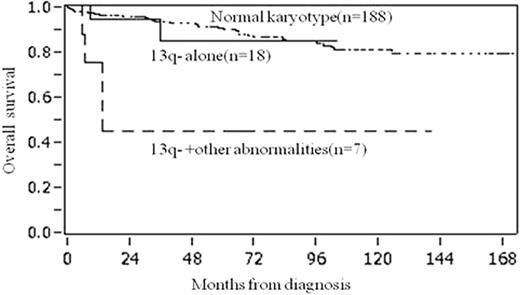Abstract
Abstract 3420
Numerical karyotypic abnormalities such as −7/del(7q) and del(13q) are occasionally seen in patients with bone marrow (BM) failure who do not have typical signs of myelodysplasia. The WHO 2008 defined this subset of BM failure as MDS-U because of its likely association with a risk of evolving into leukemia, while the presence of isolated abnormalities including +8, del(20q), and -Y was not considered to be presumptive evidence of MDS. Previous studies showed that BM failure patients with del(13q) responded to immunosuppressive therapy (IST) and had a favorable prognosis (Ishiyama K et al, Br J Haematol; 117: 747. 2002; Sloand, JCO 2010). However, the clinical features of del(13q) BM failure remain unclear due to its low incidence as well as the frequently associated karyotypic abnormalities. Objectives/Methods: To characterize the clinicopathological features of patients with BM failure with del(13q), this study reviewed the clinical data of 1705 BM failure patients (733 with AA, 286 with MDS-RCUD, 149 with RCMD, 60 with MDS-U) whose blood was examined for the presence of glycosylphosphatidyl-inositol anchored protein (GPI-AP)-deficient granulocytes and erythrocytes from May 1999 through July 2010. Genomic DNA was isolated from the peripheral blood cells of 7 patients with 13q- and was subjected to SNP array-based genome-wide analysis for genetic alterations using GeneChip® 250K arrays to identify the gene locus that is commonly deleted as a result of 13q-. Results: The 13q- clone was found in 25 (1.5%) of the 1705 patients. All the 13q- patients were classified as MDS-U, due to the absence of significant dysplasia to fulfill the criteria for MDS defined by the WHO 2008 classification. BM was hypocellular in 17 patients and normocellular in 6. Seventeen patients had a clone with 13q- alone, while the remaining 8 patients had a clone with 13q- and other numerical abnormalities including –Y, +mar in 2, and −20, del(7q), +8, der(1;7) in 1. A significant increase in the percentage of GPI-AP- granulocytes was detected in 366 (50%) of 733 patients with AA and 115 (23%) of 495 patients with MDS. GPI-AP- cells were detected in all (100%) of the 17 patients with 13q- alone. On the other hand, the prevalence of increased GPI-AP− cells in patients with 13q- plus other abnormalities and in those with the normal karyotype was 38% (3/8) and 43% (405/937), respectively. Fifteen patients with 13q- alone were treated with IST (ATG + cyclosporine in 6 and cyclosporine ± anabolic steroid in 9) and all of them achieved either a PR or a CR, while in the patients with 13q- plus other abnormalities, the response rate to IST was 40%. A total of 106 patients with the normal karyotype were treated with ATG+CsA (48) or CsA±AS (58) and the response rates were 73% and 85%, respectively. None of the 17 13q- patients progressed to advanced MDS or AML during the follow-up period of 3 to 108 months (median: 52 months) while 2 of 8 patients with 13q- plus other abnormalities developed AML. The 5-year overall survival rates of the patients with 13q-, those with 13q- plus other abnormalities, and patients with a normal karyotype were 84%, 45%, and 91%, respectively. The percentage of 13q- clones increased in 5 patients, and decreased in 3 patients after successful IST. When GPI-AP- and GPI-AP+ granulocytes were subjected to a FISH analysis using a 13q probe (13q14.3), the 13q- clones were detected only in of GPI-AP+ granulocytes, suggesting that 13q- cells are derived from non-PIG-A mutant HSCs. SNP arrays identified 13q13.3 to 13q14.3 regions in all cases. Conclusions: MDS-U with 13q- is a benign BM failure syndrome characterized by a good response to IST and a markedly high prevalence of GPI-AP cells. Patients with this type of BM failure may be inappropriately treated with hypomethylating agents or hematopoietic stem cell transplantation from unrelated donors, which is associated with high therapy-related mortality. Therefore, del(13q) should be eliminated from the intermediate prognosis group defined by the IPSS, and BM failure with del(13q) should be managed as idiopathic AA.
No relevant conflicts of interest to declare.
Author notes
Asterisk with author names denotes non-ASH members.


This feature is available to Subscribers Only
Sign In or Create an Account Close Modal